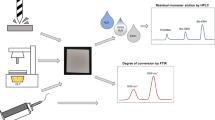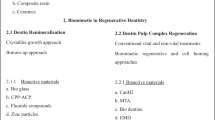Abstract
Ten commercially available denture adhesives, nine soluble formulations (six creams, three powders) and one insoluble product (pad), were analyzed regarding the cytotoxicity profile in direct and indirect assays using L929 fibroblast cells. In the direct assay, fibroblasts were seeded over the surface of a thick adhesive gel (5%, creams; 2.5%, powders and pad). In the indirect assay, cells were cultured in the presence of adhesive extracts prepared in static and dynamic conditions (0.5–2%, creams; 0.25–1%, powders and pad). Cell toxicity was assessed for cell viability/proliferation (MTT assay) and cell morphology (observation of the F-actin cytoskeleton organization by confocal laser scanning microscopy). Direct contact of the L929 fibroblasts with the thick adhesive gels caused no, or only a slight, decrease in cell viability/proliferation. The adhesive extracts (especially those prepared in dynamic conditions) caused significantly higher growth inhibition of fibroblasts and, in addition, caused dose- and time-dependent effects, throughout the 6–72 h exposure time. Also, dose-dependent effects on cell morphology, with evident disruption of the F-actin cytoskeleton organization, were seen in the presence of most adhesives. In conclusion, the adhesives possessed different degrees of cytotoxicity, but similar dose- and time-dependent biological profiles.



Similar content being viewed by others
References
Shay K (1991) Denture adhesives. J Am Dent Assoc 99:70–76
Coates A (2000) Usage of denture adhesives. J Dent 28:137–140
Douglass C, Shih A, Ostry L (2002) Will there be a need for complete dentures in the United States in 2020? J Prosthet Dent 87:5–8
Grasso J (1996) Denture adhesives: changing attitudes. J Am Dent Assoc 127:90–96
Stafford G, Russell C (1971) Efficiency of denture adhesives and their possible influence on oral microorganisms. J Dent Res 50:832–836
Hogan W (1954) Allergic reaction of adhesive denture powders. N Y S Dent J 20:65
Benson D, Rothman R, Sims T (1972) The effect of a denture adhesive on the oral mucosa and vertical dimension of complete denture patients. J S C Dent Assoc 40:468–473
Floystrand F, Koppang W, Williams V (1991) A method for testing denture adhesives. J Prosthet Dent 66:501–504
Slaughter A, Katz R, Grasso J (1999) Professional attitudes toward denture adhesives: a Delphi technique survey of academic prosthodontists. J Prosthet Dent 82:80–89
Adisman I (1989) The use of denture adhesives as an aid to denture treatment. J Prosthet Dent 62:711–715
Grasso J, Rendell J, Gay T (1994) Effect of denture adhesive on the retention and stability of maxillary dentures. J Prosthet Dent 72:399–405
Fujimori T, Hirano S, Hayakawa I (2002) Effects of a denture adhesive on masticatory functions for complete denture wearers—consideration for the condition of denture-bearing tissues. J Med Dent Sci 49:151–156
Olshan A, Ross N, Mankodi S, Melita S (1992) A modified Kapur scale for evaluating denture retention and stability: methodology study. Am J Dent 5:88–90
Garrett N, Perez P, Elbert C, Kapur K (1996) Effects of improvements of poorly fitting dentures and new dentures on masticatory performance. J Prosthet Dent 75:269–275
Kupp L, Sheridan P (2003) Denture sore mouth. Dermatol Clin 21:115–122
Bogucki Z (2008) Effects of dental adhesive materials on the retention of complete maxillary denture in patients with xerostomia in the in vivo study. Protet Stomatol 58:424–430
Boone M (1984) Analysis of soluble and insoluble denture adhesives and their relationship to tissue irritation and bone resorption. Compend Contin Educ Dent 4(Suppl):522–525
Grasso J (2004) Denture adhesives. Dent Clin North Am 48:721–733
Ekstrand B, Hensten-Pettersen S, Kullman A (1993) Denture adhesives: cytotoxicity, microbial contamination, and formaldehyde content. J Prosthet Dent 69:314–317
DeVengencie J, Ng M, Ford P, Iacopino A (1997) In vitro evaluation of denture adhesives: possible efficacy of complex carbohydrates. Intern J Prosthodont 10:61–72
Zhao K, Cheng X-R, Chao Y-L, Li Z-A, Han G-L (2004) Laboratory evaluation of a new denture adhesive. Dent Mater 20:419–424
Al R, Dahl J, Morisbak E, Polyzois G (2005) Irritation and cytotoxic potential of denture adhesives. Gerodontology 22:177–183
Gates W, Goldschmidt M, Krammer D (1994) Microbial contamination in four commercial available denture adhesives. J Prosthet Dent 71:154–158
Lamb D (1981) The effect of karaya gum on tooth enamel. Br Dent J 150:250–252
Love W, Biswas S (1991) Denture adhesives: pH and buffering capacity. J Prosthet Dent 66:356–360
Nations S, Boyer P, Love L, Burritt M, Butz J, Wolfe G et al (2008) Denture cream: an unusual source of excess zinc, leading to hypocupremia and neurologic disease. Neurology 26:639–643
International Standard ISO 10993-5 (2009) Biological evaluation of medical devices—part 5: tests for in vitro cytotoxicity. International Organisation for Standardisation, Geneva
International Standard ISO 7405 (2008) Preclinical evaluation of biocompatibility of medical devices used in dentistry—test methods for dental materials. International Organisation for Standardisation, Geneva
Stamenovic D (2005) Effects of cytoskeletal prestress on cell rheological behavior. Acta Biomater 1:255–262
Gilles R, Bolkhir M, Compere P, Libioulle C, Thiry M (1995) Effect of high osmolarity acclimation on tolerance to hyperosmotic shocks in L929 cells. Tissue Cell 27:679–687
Gilles R, Libioulle C (1998) Mechanisms of acclimation of L929 cells to hyperosmotic media. In: Arnaud MJ (ed) Hydration throughout life. John Libbey Eurotext, Paris, pp 205–209
Schmalz G, Arenholt-Bindslev D, Hiller K, Schweikl H (1997) Epithelium–fibroblast co-culture for assessing mucosal irritancy of metals used in dentistry. Eur J Oral Sci 105:86–91
Yamamoto A, Honma R, Sumita M (1998) Cytotoxicity evaluation of 43 metal salts using murine fibroblasts and osteoblastic cells. J Biomed Mater Res 39:331–340
Conflict of interest
The authors declare that they have no conflict of interest.
Author information
Authors and Affiliations
Corresponding author
Rights and permissions
About this article
Cite this article
de Gomes, P.S., Figueiral, M.H., Fernandes, M.H.R. et al. Cytotoxicity of denture adhesives. Clin Oral Invest 15, 885–893 (2011). https://doi.org/10.1007/s00784-010-0464-0
Received:
Accepted:
Published:
Issue Date:
DOI: https://doi.org/10.1007/s00784-010-0464-0




